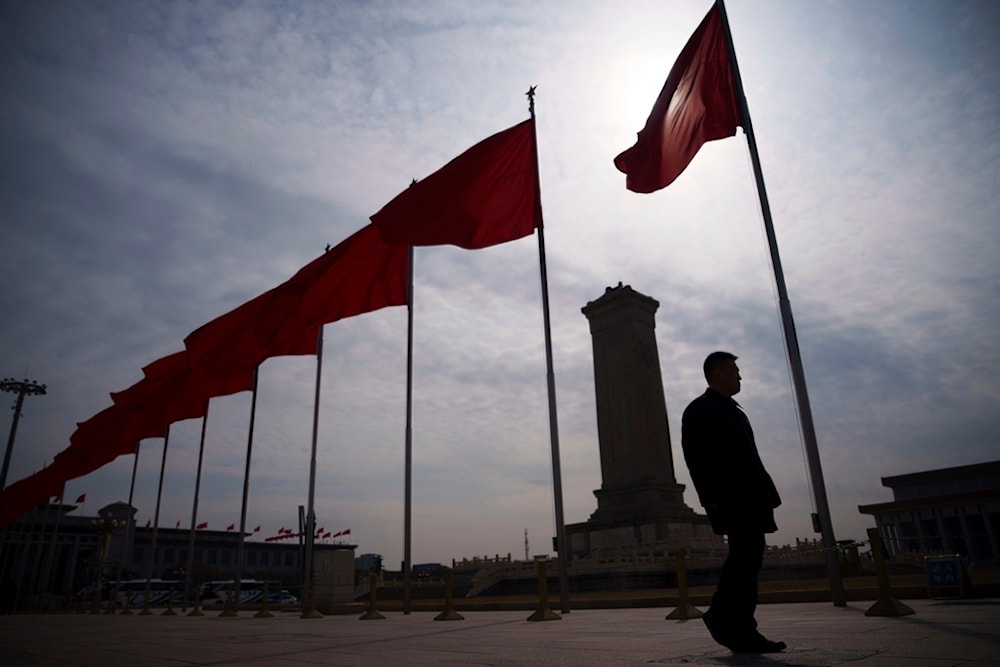West using Tibet human rights as tool for destabilization: China
Prior to Chinese governance, Tibet under the Dalai Lama was a feudal theocracy where the majority lived as serfs, facing severe poverty, low literacy, and minimal access to healthcare, according to the white paper.
-

A man walks near red flags on Tiananmen Square during a preparatory session meeting of China's National People's Congress (NPC) in Beijing, China, on Tuesday, March 4, 2025. (AP)
Chinese authorities have rejected Western accusations regarding the state of human rights in Tibet, describing them as politically driven distortions aimed at undermining national unity. In a newly released white paper titled "Development and Progress of Human Rights in Tibet in the New Era", officials noted that under Chinese governance, the region has experienced profound social and economic transformation.
The document, presented Friday by Garma Cedain, Vice Chairman of the Tibet Autonomous Region Party Committee, accused the United States and other Western nations of collaborating with the Dalai Lama to disseminate what it called fabricated narratives.
"For years, anti-China forces in the United States and other Western countries, in league with the Dalai Lama, have been spreading lies about the 'worsening human rights situation' in Tibet. These fictitious claims are purely political in nature and completely ignore the facts," the paper stated.
Chinese officials argue that these accusations serve a broader goal of encouraging separatism and creating instability in Tibet. "A lie repeated a thousand times remains a lie. The progress in human rights in Tibet will not be undermined or reversed by lies, nor will the gains made in the new era by people of all ethnic groups in the region be reversed by deception," the document added.
Tibet transformation
The white paper situates China's position within a broader historical context. Before 1951, Tibet operated as a feudal theocracy under the rule of the Dalai Lama and an elite monastic class. The majority of the population lived as serfs under harsh conditions, with extremely low literacy rates and life expectancy averaging just 35 years. Healthcare was virtually nonexistent, and nearly 12% of the capital's population reportedly lived by begging.
After the signing of the 17-Point Agreement in 1951, Tibet was formally incorporated into the People's Republic of China. Chinese authorities assert that they dismantled feudal structures, launched sweeping land reforms, and invested heavily in public services.
The state financed the construction of roads, power plants, hospitals, and schools, dramatically increasing access to electricity, education, and medical care. Economic reforms implemented in the 1980s also expanded local autonomy over agriculture and pastoral livelihoods, contributing to improved living standards.
Beijing's policies in Tibet have drawn criticism from the West, particularly over allegations of cultural assimilation and religious regulation. China maintains that such claims are exaggerated and politically motivated, serving to obscure the tangible improvements in quality of life.
Read more: Xi reaffirms commitment to Taiwan reunification in new year address
The white paper reaffirms China's position that Tibet is an inalienable part of its territory and argues that foreign-led campaigns questioning Chinese sovereignty over the region are efforts to "split Tibet from China under the pretext of being concerned about alleged human rights violations."
Beijing continues to portray its policies in Tibet as a model of ethnic development and modernization, rejecting foreign narratives that it sees as part of a long-standing effort to destabilize the region.

 3 Min Read
3 Min Read








